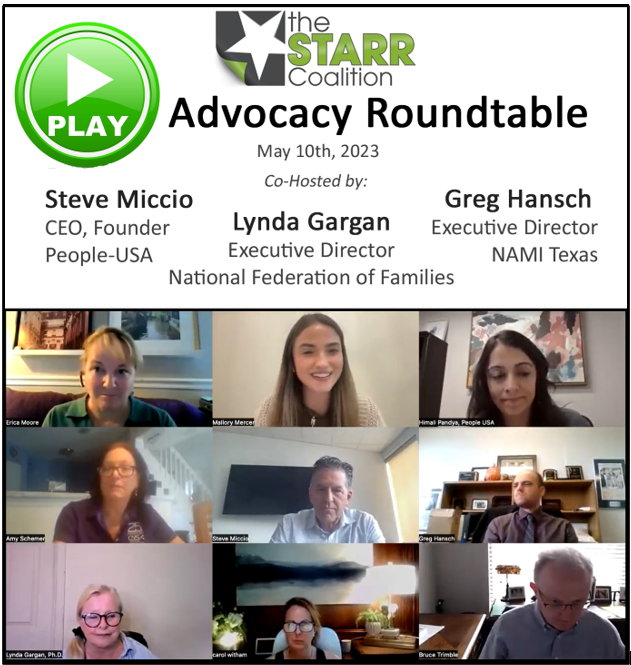We all know that research is the only way to find new treatments for mental illnesses. Participation in research improves patient outcomes, helps individuals participating in research feel more engaged in their healthcare journey, provides access to cutting-edge treatments and high-quality care to patients, and it changes lives. That’s why it is important that research sites are a familiar and trusted part of the community and especially, the mental health community. The STARR Coalition can help identify key community partners and offer support, tips, and tools for your outreach strategy.
The STARR Coalition will assist your site in beginning the process of building relationships within your community and with local or state advocacy. It has been our experience that sometimes local advocacy groups are reluctant to partner with clinical research for various reasons: mistrust of clinical research, past history when working with sites, or simply no desire to associate with research. No matter the barriers, clinical research sites must become a part of the care continuum so that individuals living with mental illnesses have clinical research as an care option. We will call upon national partners if needed to open the conversation at the local level.
PURPOSE
Advocacy organizations use various forms of advocacy in order to influence public opinion and/or policy. They have played and continue to play an important part in the development of political and social systems. Advocacy groups fulfill their mission in different ways through national, state and local affiliates.
Clinical research’s partnerships are as varied as the indications themselves. Many advocacy organizations for disease states such as cancer, heart disease, diabetes and others work closely with research, often raising money for new cutting-edge therapies. Yet other indications such as brain disorders, do not receive the same support from advocacy and sadly, our society.
It is vital that clinical research, especially the sites at the local level, become involved in advocacy. This can take many forms, but always with the intent to better serve the volunteers entering a clinical trial. Research must educate themselves on local advocacy organizations, their mission, and how advocacy can become a support network for those entering a trial.
HOW TO GET INVOLVED
There are many ways research sites can support local advocacy. Here are a few examples:
- Sponsor an event such as a walk or fundraiser.
- Allow staff to volunteer in events or operational pieces needed by advocacy groups.
- Offer your resources to assist in disease education.
- Actively participate in community events.
- Share staff to assist in programs held by advocacy, i.e. having a nurse lead a family education group about medications.
- Hold a community health fair and invite other organizations involved in a specific indication.
- Assess the needs of advocacy in your community and fill those needs.
- Open your doors to advocacy leaders to educate them on the work you are doing. Hold an Open House, invite their staff/board in for lunch, allow them to use your space for meetings. Be creative. You are only limited by your imagination.
- Serve on a Board. Many groups appreciate and desire active participation.
- Reach out to other STARR Certified Sites and learn ways they are engaging advocacy and the community.
POTENTIAL PITFALLS
Advocacy outreach is NOT A RECRUITING TOOL. It is not the mission or obligation of advocacy to find volunteers for your trial. It’s great to share study information and introduce them to the resources available at your site, but don’t ask for or expect referrals. If you approach the partnership with this expectation, it will fail.
The process of establishing a trust-based partnership with advocacy can take time. Be patient and be persistent. It will benefit both the volunteers and your site. Remember, we are here as a resource as needed in this area.
EXAMPLES OF ADVOCACY ORGANIZATIONS
The following organizations are among the top national advocacy organizations for mental health in the US. Most of them have affiliate chapters at the state and local level. You can see through the descriptions how they each have a unique mission and serve a different purpose in the system of care.
Mental Health America (MHA) — Founded in 1909, MHA has an established record of effective national and grassroots advocacy and achievement. With over 200 affiliates in 41 states, 6,500 affiliate staff and over 10,000 volunteers, they are a powerful voice for healthy communities throughout the nation. Much of their current work is guided by the Before Stage 4 (#B4Stage4) philosophy – that mental health conditions should be treated long before they reach the most critical points in the disease process. For more information visit www.mentalhealthamerica.net
Depression Bipolar Support Alliance (DBSA) — DBSA envisions wellness for people who live with depression and bipolar disorder. Because DBSA was created for and is led by individuals living with mood disorders, their vision, mission, and programming are always informed by the personal, lived experience of peers. Through more than 700 support groups and nearly 300 chapters, DBSA reaches millions of people each year with in-person and online peer support; current, readily understandable information about depression and bipolar disorder; and empowering tools focused on an integrated approach to wellness. For more information visit www.dbsalliance.org
National Alliance on Mental Illness (NAMI) — NAMI is the nation’s largest grassroots mental health organization dedicated to building better lives for the millions of Americans affected by mental illness. NAMI is the foundation for hundreds of NAMI State Organizations, NAMI Affiliates and volunteer leaders who work in local communities across the country to raise awareness and provide essential and free education, advocacy and support group programs. For more information visit www.nami.org
The Jed Foundation is a nonprofit that protects emotional health and prevents suicide for our nation’s teens and young adults. We’re partnering with high schools and colleges to strengthen their mental health, substance misuse, and suicide prevention programs and systems. We’re equipping teens and young adults with the skills and knowledge to help themselves and each other. We’re encouraging community awareness, understanding and action for young adult mental health. JED believes that we can promote mental health and prevent suicide among teens and young adults by empowering them as individuals, strengthening their schools, and mobilizing the communities and influences in their lives. For more information visit https://jedfoundation.org
The Schizophrenia & Psychosis Action Alliance (formerly SARDAA) works to improve lives affected by schizophrenia-related brain illnesses (mental illnesses involving psychosis). The Schizophrenia & Psychosis Action Alliance promotes hope and recovery through support programs, education, collaboration and advocacy. Our vision is that every person living with a schizophrenia-related brain disorder receives respect, appropriate treatment and an opportunity to live a meaningful and satisfying life in a compassionate community free of discrimination. Learn more at https://sczaction.org/
